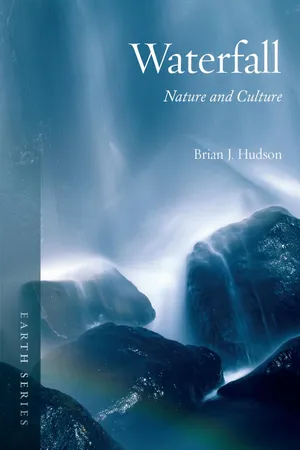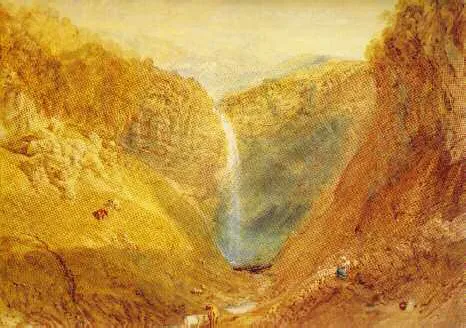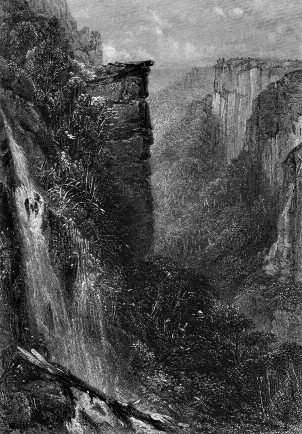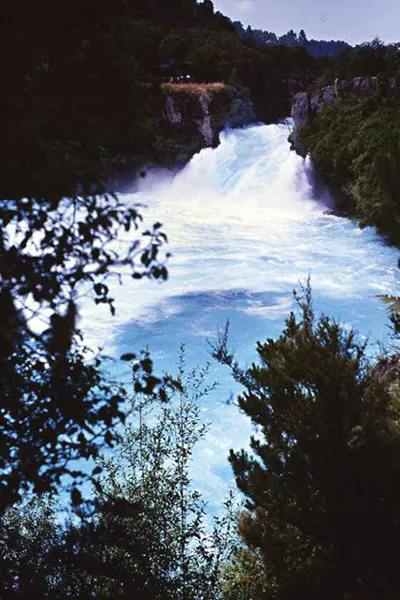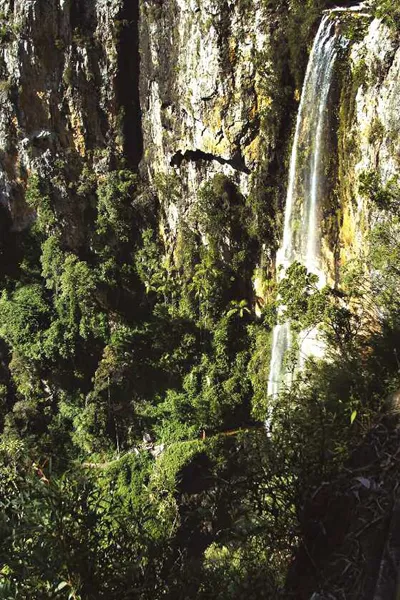![]()
1 Waterfall Lovers and Waterfalling
‘Waterfalls have universal appeal . . .’
Griff Fellows, The Waterfalls of England1
‘Good waterfalling!’
Mary Welsh, More Walks to Yorkshire Waterfalls2
Many people take delight in waterfalls. They are variously known as waterfall lovers, fans, buffs or even collectors, although all that these enthusiasts are likely to take and keep are photographs. Treasured memories may also be kept in travel notes, letters and diaries. Armed with cameras, or perhaps with sketchbooks and pencils, they may, like the poets Wordsworth and Coleridge, set out ‘to hunt waterfalls’, as Dorothy Wordsworth expressed it in her diary.3 Today this activity is commonly referred to as ‘waterfalling’, and among enthusiasts the term ‘waterfallology’ has come into use to describe the study of or active interest in waterfalls.
Waterfall lovers come from all walks of life and can be found all over the world. Some rural communities value their local water-falls as places of relaxation where they can bathe in the tumbling streams with their refreshing cascades and inviting rockpools, then rest on the banks. Today, villagers in the mountains behind Finschhafen in Papua New Guinea walk to a little waterfall to enjoy a natural jacuzzi massage reputed to have healing powers.
Nowadays, most waterfall lovers are people who just like to visit waterfalls while on holiday or on excursions into the countryside. Waterfalls are popular destinations for day trips by car, often involving a short walk along the way or, for more remote falls, arduous hikes. They are commonly among the beauty spots that are visited on commercially operated tours. Some waterfall lovers take their interest more seriously, however. Many spend much of their leisure time searching for waterfalls that they have not seen before and revisiting favourites with which they are familiar, enjoying them under various conditions that change according to season and weather. Some of these people are keen amateur and professional photographers who have a particular liking for waterfalls as subjects for their pictures. Others are more systematic in their approach, exploring particular areas and recording the falls they discover there, keeping detailed records of their height, width, flow and other characteristics. There are several highly informative and authoritative waterfall websites among the hundreds on the Internet. Many more are collections of photographic images, often holiday snapshots and accounts of trips.
J.M.W. Turner, Hardraw Force, 1816–18, watercolour. This waterfall in the Yorkshire Dales has been popular with ‘waterfall lovers’ since the 18th century.
Waterfalls, cascades and cataracts
Our most common experience of falling water is rain, but although we may enjoy this natural phenomenon, it does not give us that special pleasure we experience when visiting a waterfall. A water fall may be defined as a ‘vertical or very steep
descent in a watercourse’, but how steep does it have to be to qualify? At what angle does it cease to be a waterslide or rapid and become a waterfall? Even on a vertical or overhanging rock face, water streaming or trickling down may appear to the observer to be insufficient in quantity to make it a waterfall. Even well-known named falls may not always convince the observer that the descending water constitutes what is properly called a waterfall. When nineteenth-century travellers Samuel Mossman and Thomas Banister visited Wentworth Falls in New South Wales, Australia, ‘a famous waterfall on the Blue Mountains’, they were ‘so disappointed at the small volume of water it displayed’ that they felt ‘it was scarcely sufficient . . . to be considered a waterfall’.4 Like many others, this much painted and photographed cascade is often reduced to a trickle in dry weather and may even dry up entirely.
Thomas Heawood, Fall of Weatherboard, engraving; original drawing by John Skinner Prout (1805–1875). |
|
While some ‘waterfallologists’ debate the criteria for defining a waterfall, more interesting to me is the use of the words ‘cascade’ and ‘cataract’, which are often applied to falls of various kinds. Dictionary definitions help, but uncertainties remain. A cascade may mean ‘a small waterfall’ or ‘a series of waterfalls’. It is not clear whether the falls in a cascade that is a series of waterfalls have to be small. A cataract may be ‘a precipitous waterfall’ or ‘a large waterfall’. One geographer suggests a more precise definition of a cataract, applying the term to ‘a steep fall of less than 75° in a watercourse which may also include a number of small waterfalls. The total height of these waterfalls will be less than the total cataract height.’5 This definition implies that a cataract is less precipitous than a waterfall, yet Niagara Falls and Victoria Falls, both extremely precipitous, are commonly described as cataracts. They are certainly large waterfalls in terms of width and volume, though not particularly high in world terms. The famous Cataracts of the Nile, on one of the world’s greatest rivers, cannot be considered as waterfalls and are best described as rapids, stretches where the flow is especially fast and often broken by rocks. On another of Africa’s great rivers there are what Edward Rashleigh dismissively described as ‘the so-called falls of the Congo’.6 Most notable among these are the Boyoma (previously the Stanley) Falls which, though more impressive than the Nile Cataracts, like the latter are not true waterfalls but rapids. In seven main descents they fall 60 metres over a 100 kilometre stretch of river. These, too, are often referred to as cataracts.
Very tall waterfalls tend to be relatively narrow and small in volume. They often descend in several leaps, thus making them cascades in one sense – ‘a series of waterfalls’ – even though falls of this kind can hardly be described as ‘small’, the other definition. Yosemite Falls, for example, cascades 739 metres down its cliff face in three great leaps, and are generally regarded as one of the giants in the world of waterfalls. In my book, any vertical or very steep drop in the course of a river or stream can be termed a waterfall. Some falls may be interrupted by ledges or may descend in a series of steps, thus becoming a cascade, but I also use the latter term to apply to small waterfalls, particularly those where the volume is slight. To me, the word ‘cascade’ suggests a delicacy that may be displayed in falls which occur as a series of shallow steps or a waterfall that descends as a fine, transparent curtain. In contrast, I apply the word ‘cataract’ to falls that are huge in volume, tumbling tumultuously over a brink that may be wide though not necessarily very high. I use the word ‘falls’ both in a plural sense, referring to more than one waterfall, and as a singular term where one particular waterfall is being mentioned. This is common in the literature, as in the example, ‘The Huka Falls is New Zealand’s most visited natural attraction.’ What it is that attracts us to waterfalls is the subject of a later chapter, but before considering this, it is appropriate to examine the origins of waterfalls, the way they evolve and the life in and around the tumbling streams.
Multnomah Falls, Oregon, descends 189 metres in two major steps. Built in 1914, the Benson Bridge affords pedestrians spectacular views from midway up the waterfall. |
|
Opposite: Huka Falls.
Huka Falls on North Island, New Zealand, is noted for its powerful flow and brilliant blue colour.
Purlingbrook Falls, Queensland, one of the many waterfalls to be seen in Australia’s Gold Coast hinterland.
![]()
2 Waterfalls: Birth, Life and Death
‘Waterfalls are significant items for geomorphic interpretation.’
O. D. von Engeln, Geomorphology: Systematic and Regional1
‘Waterfalls are common, with white water spraying over the rounded black boulders . . . as it travels at break-neck speed it seems impossible that anything could live in it.’
David Boag, The Living River2
The global distribution of waterfalls
Waterfalls are unevenly distributed, rare or entirely absent over most of the earth’s surface but common in some regions. This is because the conditions required for the formation of waterfalls are highly localized. While over 70 per cent of the earth’s surface is covered with water, most of it is in the oceans and seas. Of the 2.8 per cent of the world’s water found on land, most is in the form of ice at the poles and in glaciers. Less than one per cent of the world’s water is fresh and of this, running water makes up only a tiny part. At any given time, as little as 0.0001 per cent of the total quantity of water on earth is in river channels, and the area that they occupy is only about a thousandth of the entire land surface.3
Waterfalls can occur only where there are marked variations in the altitude of land, so they are absent from flat, low-lying areas such as coastal and alluvial plains. They can occur in terrain that is generally level or gently undulating as long as it is sufficiently elevated and traversed by rivers that have eroded pronounced valleys or gorges in their downstream reaches, as at Niagara and Victoria Falls. Hilly or mountainous areas, plateau edges and some coasts that have suitable geological conditions or with particular geomorphological histories are most likely to have waterfalls, as long as there are rivers or streams. Arid regions normally do not have permanent waterfalls unless they are traversed by rivers from wetter regions, as in the case of Augrabies Falls on the Orange River, which sustains its flow when it enters the Kalahari Desert. Even in deserts, however, the occasional rainstorm can generate spectacular ephemeral falls, such as those seen occasionally at Australia’s Uluru, also known as Ayers Rock.
Many of the world’s best-known waterfalls are found in North America and Europe. Switzerland and Norway have many famous examples, which is not surprising in view of their rugged mountains and ample rainfall and s...
